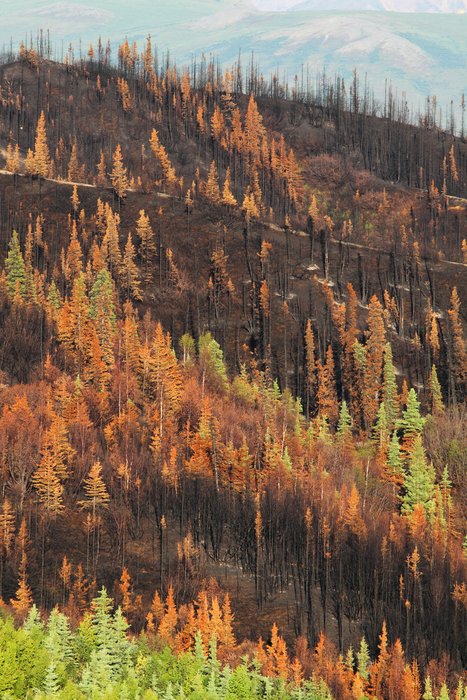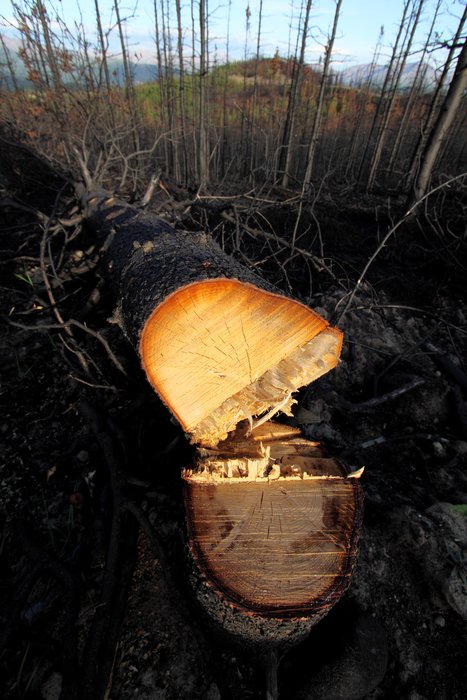
- State of Alaska - Department of Natural Resources
- Alaska Native Corporations
- U.S. Forest Service Region 10 (Alaska) Strategic Goals
- Other Government Forest Land Managers
Land in Alaska is managed by the Federal government (51%), local governments (25%), Native Corporations (24%) and private landowners (0.4%). All four of these groups own and manage tracts of Alaska forest. Debate continues over priorities for the use and reasonable regulation of this resource. The logging industry points out the need for timber and the employment brought by logging, but salmon fishermen, hunters, subsistence users, and the tourist industry support forest conservation.

Alaska’s Federal lands, a substantial portion of which are forested, are themselves are controlled by many organizations with different policies and charters: the Bureau of Land Management, the Forest Service, the Fish & Wildlife Service, the National Park Service, and the Department of Defense. , The Department of Defense (DoD), perhaps the least-known owner of federal forest land, alone controls 1.7 million acres of Alaska land, making it the 5th largest federal landowner. Much of the DoD land is dry, cold-weather woodlands in the interior near Fairbanks and Delta Junction.
State of Alaska - Department of Natural Resources
The State of Alaska owns 89.8 million acres of the state - more than any other entity. Its holdings include interior forests, small parcels of coastal rainforest, and most of the transitional forests which fill the Matanuska-Susitna Valley and are biologically intermediate between the wet coastal rainforests and the dry, cold-weather interior forests. The Alaska Department of Natural Resources manages this land.
The Alaska Department of Natural Resources Division of Forestry has outlined 5 key issues 5 MB framing discussions of forestry management:

Fire represents both a critical aspect of forest health and, at times, a significant danger to human habitation. Over a million acres of forest burns every year in Alaska. The number and intensity of fires has been growing over the last few decades, due primarily to a combination of deadfall from the spruce beetle epidemic, and the effects of climate change.
Sustainable forest products includes not just timber for construction, but wood and biomass for fuel on both an industrial and personal use scale. Timber production has ranged between 8 and 61 million board feet annually over the last decade, and currently represents about 1.6% of the Alaskan economy. Logging, particularly clear-cutting, can have significant negative impact on salmon habitat, erosion control, water quality, and general ecosystem quality. However, selective logging can minimize these impacts.
Forest health concerns disease, pests such as the spruce bark beetle, and the effects of climate change on forest ecosystems.
Community benefits from forests include recreation, tourism, hunting/fishing, and subsistence.
Ecosystem services provided by Alaskan forests include water and air quality, and fish and wildlife habitat. Forests are critical for maintaining salmon spawning habitat, which in turn has large economic, social, and ecological value.
Alaska Native Corporations
With 39.3 million acres of Alaska under their care, including large swathes of forested (or formerly forested) land, Alaska Native Corporations (ANCs) own a large collective swathe of Alaska’s forests Surface resource rights (including timber) for much of this land are owned by individual village corporations, fragmenting this large total forest ownership among numerous small corporations. With 13 major regional native corporations and numerous village corporations established in Alaska, there is no single, cohesive management plan for ANC lands.
Historically, many ANCs have logged their lands for export during times of high timber values. Such harvests were not intended to be sustainable, but to convert timber assets into cash. In the mid-1980s, loss-selling played a major role in ANC logging, and according to critics it encouraged reckless deforestation and asset destruction.
U.S. Forest Service Region 10 (Alaska) Strategic Goals
The U.S. Forest Service is disproportionately important in Alaska forest management, due to the nature of its holdings. It manages 22.3 million acres of Alaska’s forests, making it only the 6th largest owner of forest land. However, the National Forests encompass most of the coastal rainforests in Alaska that are not incorporated into National Parks. This makes the Forest Service the primary steward of most of Alaska’s high-productivity, logging-eligible rainforest.
The National Forests are concentrated in the temperate rainforest belts of the southern and southeastern coasts, where its overall goals include forest management and promoting the economic development of rural communities. The U.S. Forest Service’s strategic plan for Alaska, 2008-2012 identifies goals in three areas:
Invasive Species: The detection and reporting non-native, invasive species is a priority. This includes plants, insects, and diseases, such as the spruce beetle, leaf miner moths, and spotted knapweed. A changing climate has increased Alaska’s vulnerability to invasive species.
Climate Change: The plan calls for observing the effects of climate change on the National Forests, predicting more long-term climate changes and impacts, and developing new forestry strategies to adapt to them. The Forest Service has gone so far as to list another objective: redefining “forest health” to take climate change’s effects into account, since presumably old yardsticks for forest health, from tree growth rates to insect outbreaks, will all change along with climate.
Communication: Lastly, the Region 10 strategic plan prioritizes communication with forest stakeholders.
Wildfire suppression and timber sales are notably absent from the USFS Region 10 Strategic Goals. The National Forests are predominantly coastal rainforests, which are too wet for severe burning. Wildfire is not a problem. Perhaps more surprising is the absence of timber sales, despite the heavy support given to logging in the Tongass National Forest, through road construction and the administration and management of timber. The actual quantity of logging is small - less than 2,000 acres in 2011.
Other Government Forest Land Managers

The Bureau of Land Management (BLM) and the U.S. Fish & Wildlife Service (FWS) are the 2nd and 3rd largest land-managers in the state, respectively responsible for 82.5 and 78.8 million acres of land. Much of this land is open tundra and boreal forest (the dry, cold-weather, spruce-dominated forests of the far north). However, FWS also manages substantial tracts of the Kenai Peninsula and Kodiak Island (as well as much of the sparsely forested Alaska Peninsula), and the BLM controls enclaves near Cordova and Skagway.
The BLM employs a multi-use management plan to manage lands open for human use, including commercial timber sales, harvesting for house logs, firewood, wildlife management, subsistence activities, and recreation. Much of the BLM’s land is interior, and therefore of marginal value for commercial logging. The Fish & Wildlife Service primarily manages Alaska’s large National Wildlife Refuges (including the famous Arctic National Wildlife Refuge), and pursues more conservation-oriented policies.
The BLM is also the primary agency responsible wildfire suppression in Alaska, and operates the Alaska Fire Service, which includes the Alaska Smokejumpers. It is directly responsible for fire suppression on all BLM and Native Corporation lands - a combined area equal to roughly 1/6 of the state. Wildfire suppression forces in Alaska practice interagency cooperation, and BLM forces frequently respond to fires on other lands.
Finally, the National Park Service manages 52.4 million acres of land, including large portions of the Alaska Range, Brooks Range, and Wrangel-St. Elias Mountains, as well as smaller section of the Aleutian Range, Yukon delta, Kenai Peninsula, SE Alaska, and upper Yukon. While the National Park Service lands contain significant forests, they are heavily concentrated in mountainous areas. Traditional activities, including those related to subsistence, are permitted in Alaska’s parks, but forestry management is limited.
Created: Jan. 19, 2018